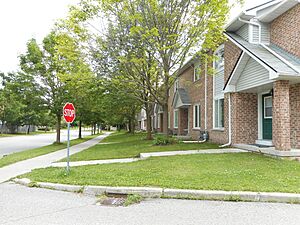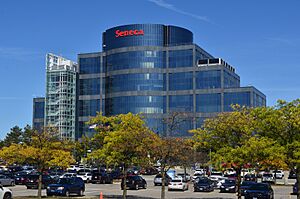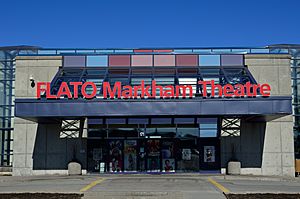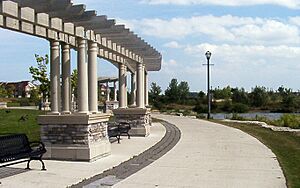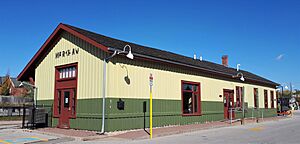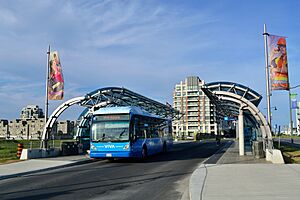Markham, Ontario facts for kids
Quick facts for kids
Markham
|
|||||
|---|---|---|---|---|---|
| City of Markham | |||||
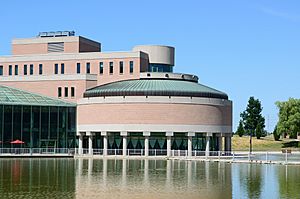
|
|||||
|
|||||
| Nickname(s):
The High-Tech Capital
|
|||||
| Motto(s):
Leading While Remembering
|
|||||

Location of Markham within York Region
|
|||||
| Country | Canada | ||||
| Province | Ontario | ||||
| Regional Municipality | York Region | ||||
| Settled | 1794 (Thornhill and Unionville) | ||||
| Incorporated | 1872 (village) 1971 (town) 2012 (city) |
||||
| Area | |||||
| • Total | 210.93 km2 (81.44 sq mi) | ||||
| Elevation | 200 m (700 ft) | ||||
| Population
(2021)
|
|||||
| • Total | 338,503 (16th) | ||||
| • Density | 1,604.8/km2 (4,156/sq mi) | ||||
| Demonym(s) | Markhamite | ||||
| Time zone | UTC−05:00 (EST) | ||||
| • Summer (DST) | UTC−04:00 (EDT) | ||||
| Forward Sortation Area |
L3P to L3S, L6B to L6G
|
||||
| Area codes | 905, 289, 365, and 742 | ||||
| ISO 3166-2 | CA-ON | ||||
| GNBC Code | FDNFZ | ||||
Markham is a busy city in York Region, Ontario, Canada. It's about 30 kilometers northeast of Downtown Toronto. In 2021, Markham had a population of 338,503 people. This makes it the largest city in York Region and the 16th largest in all of Canada!
The city was named by John Graves Simcoe, who was the first leader of Upper Canada. He named it after his friend, William Markham, who was an important church leader.
People have lived in the Markham area for thousands of years. The first European settlers arrived in 1794. A German artist named William Moll Berczy brought about 64 German families to the area. Over time, Markham changed from a farming community to a city with many businesses and industries. On July 1, 2012, Markham officially became a city.
Today, Markham is known for its many businesses, especially in technology. It has over 1,000 tech and life-sciences companies. Many big companies like Honda Canada, Hyundai, IBM, and Johnson & Johnson have their Canadian headquarters here. This is why Markham is often called "Canada's High-Tech Capital."
Contents
- Exploring Markham: A City of Innovation and History
- A Look Back: Markham's History
- Where is Markham?
- Markham's Communities
- Markham's People: A Diverse Community
- City Services: Keeping Markham Running Smoothly
- Learning in Markham: Schools and Colleges
- Markham's Economy: A Hub for Technology
- Arts and Culture in Markham
- Sports and Recreation
- Parks and Green Spaces
- Fun Places to Visit in Markham
- Annual Events and Festivals
- Shopping in Markham
- Local Media: Staying Informed
- Getting Around Markham: Transportation
- Partner Cities: Markham's Global Connections
- Images for kids
- See also
Exploring Markham: A City of Innovation and History
A Look Back: Markham's History
Long before Europeans arrived, Indigenous people lived in the Markham area. This land is the traditional home of the Haudenosaunee, Huron Wendat, Petun, and Neutral peoples. When French explorers came in the early 1600s, they met the Huron-Wendat First Nation.
Parts of Markham are covered by old agreements like the Toronto Purchase of 1787. This agreement transferred land from the Mississauga people to the British Crown. Other parts are covered by the Johnson-Butler Purchase and the Williams Treaties signed in 1923.
European settlement in Markham began in 1794. John Graves Simcoe, the leader of Upper Canada, named the area after his friend, William Markham. William Berczy led 75 German families to the area in 1794. Many of these families were Pennsylvania Dutch and Mennonites. They were skilled farmers and craftspeople. They helped the region grow and founded a place called Reesorville, which later became Markham Village.
By the 1830s, many Irish, Scottish, and English families also moved to Markham. The area's rivers and streams were used to power sawmills and gristmills (for grinding grain). As roads improved, like Yonge Street, more people moved in. By 1842, Markham had a population of 5,698.
In 1871, the first train line came to Markham Village and Unionville. This helped the area grow even more. In 1971, Markham officially became a town. Its population grew very quickly as people moved from nearby Toronto. Much of Markham's farmland turned into new neighborhoods.
In 2012, Markham changed its official status from a "town" to a "city." This change simply recognized that many people already thought of Markham as a city because of its size and growth.
Where is Markham?
Markham covers an area of about 212 square kilometers. Its center is located at 43°53′N 79°15′W. It shares borders with five other cities and towns:
- To the west: Vaughan and Richmond Hill.
- To the south: Toronto.
- To the north: Whitchurch–Stouffville.
- To the east: Pickering.
Markham's Landscape and Rivers
Markham is generally made up of gently rolling hills. The city's average height is about 200 meters above sea level. Two main rivers, the Don River and Rouge River, flow through Markham, along with their smaller streams. To the north, the land gets even higher because of the Oak Ridges Moraine.
Markham's Climate
Markham has a climate similar to Toronto's. It has warm, humid summers with rain from May to October. Winters are cold and snowy. The highest temperature ever recorded was 37.8°C in August 2001. The lowest was -35.2°C in January 1994.
| Climate data for Markham (Buttonville at Toronto Buttonville Airport) WMO ID: 71639; coordinates 43°51′44″N 79°22′12″W / 43.86222°N 79.37000°W; elevation: 198.1 m (650 ft); 1981–2010 normals |
|||||||||||||
|---|---|---|---|---|---|---|---|---|---|---|---|---|---|
| Month | Jan | Feb | Mar | Apr | May | Jun | Jul | Aug | Sep | Oct | Nov | Dec | Year |
| Record high humidex | 16.0 | 14.4 | 29.2 | 35.7 | 41.0 | 44.6 | 50.9 | 47.4 | 43.6 | 37.8 | 24.9 | 20.6 | 50.9 |
| Record high °C (°F) | 14.9 (58.8) |
14.9 (58.8) |
26.0 (78.8) |
31.7 (89.1) |
34.6 (94.3) |
36.6 (97.9) |
37.2 (99.0) |
37.8 (100.0) |
34.4 (93.9) |
31.0 (87.8) |
22.1 (71.8) |
18.0 (64.4) |
37.8 (100.0) |
| Mean daily maximum °C (°F) | −1.5 (29.3) |
−0.9 (30.4) |
4.5 (40.1) |
12.1 (53.8) |
19.1 (66.4) |
24.6 (76.3) |
27.1 (80.8) |
26.0 (78.8) |
21.5 (70.7) |
14.1 (57.4) |
7.2 (45.0) |
0.9 (33.6) |
12.9 (55.2) |
| Daily mean °C (°F) | −5.8 (21.6) |
−5.6 (21.9) |
−0.4 (31.3) |
6.7 (44.1) |
13.0 (55.4) |
18.6 (65.5) |
21.2 (70.2) |
20.2 (68.4) |
15.7 (60.3) |
8.9 (48.0) |
3.1 (37.6) |
−2.9 (26.8) |
7.7 (45.9) |
| Mean daily minimum °C (°F) | −10.1 (13.8) |
−10.2 (13.6) |
−5.3 (22.5) |
1.2 (34.2) |
6.8 (44.2) |
12.6 (54.7) |
15.2 (59.4) |
14.3 (57.7) |
9.9 (49.8) |
3.6 (38.5) |
−1.1 (30.0) |
−6.8 (19.8) |
2.5 (36.5) |
| Record low °C (°F) | −35.2 (−31.4) |
−25.7 (−14.3) |
−25.6 (−14.1) |
−10.1 (13.8) |
−2.1 (28.2) |
1.9 (35.4) |
6.9 (44.4) |
4.2 (39.6) |
−2.0 (28.4) |
−7.4 (18.7) |
−15.0 (5.0) |
−26.0 (−14.8) |
−35.2 (−31.4) |
| Record low wind chill | −42.6 | −37.4 | −35.6 | −18.6 | −4.4 | 0.0 | 0.0 | 0.0 | −4.2 | −8.8 | −23.9 | −36.6 | −42.6 |
| Average precipitation mm (inches) | 62.1 (2.44) |
50.5 (1.99) |
53.2 (2.09) |
74.1 (2.92) |
79.6 (3.13) |
82.8 (3.26) |
79.0 (3.11) |
76.2 (3.00) |
81.8 (3.22) |
68.0 (2.68) |
80.0 (3.15) |
65.7 (2.59) |
852.9 (33.58) |
| Average rainfall mm (inches) | 26.0 (1.02) |
22.9 (0.90) |
33.6 (1.32) |
66.7 (2.63) |
79.5 (3.13) |
82.8 (3.26) |
78.8 (3.10) |
76.2 (3.00) |
81.8 (3.22) |
66.7 (2.63) |
68.3 (2.69) |
34.2 (1.35) |
717.4 (28.24) |
| Average snowfall cm (inches) | 38.9 (15.3) |
29.9 (11.8) |
19.3 (7.6) |
7.5 (3.0) |
0.1 (0.0) |
0.0 (0.0) |
0.0 (0.0) |
0.0 (0.0) |
0.0 (0.0) |
0.6 (0.2) |
12.1 (4.8) |
34.2 (13.5) |
142.6 (56.1) |
| Average precipitation days (≥ 0.2 mm) | 16.7 | 12.9 | 12.0 | 12.3 | 12.0 | 11.8 | 11.2 | 9.9 | 10.8 | 13.2 | 14.5 | 15.3 | 152.7 |
| Average rainy days (≥ 0.2 mm) | 5.8 | 3.8 | 6.7 | 10.8 | 12.0 | 11.8 | 11.2 | 9.9 | 10.8 | 13.0 | 11.3 | 6.6 | 113.7 |
| Average snowy days (≥ 0.2 cm) | 13.4 | 10.8 | 7.0 | 2.9 | 0.13 | 0.0 | 0.0 | 0.0 | 0.0 | 0.48 | 4.7 | 10.8 | 50.2 |
| Average relative humidity (%) (at 1500 LST) | 69.6 | 64.0 | 57.8 | 52.9 | 52.3 | 53.9 | 53.4 | 55.9 | 59.2 | 62.4 | 68.9 | 71.1 | 60.1 |
| Source: Environment and Climate Change Canada | |||||||||||||
Markham's Communities
Markham is made up of many unique communities, some of which started as small villages in the 1800s. Even though they are now part of a big city, many still have their own special feel.
- Almira
- Angus Glen
- Armadale
- Bayview Glen
- Berczy Village
- Box Grove
- Brown's Corners
- Bullock
- Buttonville
- Cachet
- Cashel
- Cathedraltown
- Cedar Grove
- Cedarwood
- Cornell
- Crosby
- Dollar
- Downtown Markham
- Dickson's Hill
- German Mills
- Greensborough
- Hagerman's Corners
- Langstaff
- Legacy
- Locust Hill
- Markham Village
- Middlefield
- Milliken Mills
- Milnesville
- Mongolia
- Mount Joy
- Quantztown
- Raymerville – Markville East
- Rouge Fairways
- Sherwood – Amber Glen
- South Unionville
- Thornhill
- Underwood, Ontario
- Unionville
- Uptown Markham
- Victoria Square
- Vinegar Hill
- Wismer Commons
Two well-known communities are Thornhill and Unionville. Thornhill is actually split between Markham and Vaughan. Unionville has three parts: the original village, South Unionville (a newer residential area), and Upper Unionville (a new development).
Markham's People: A Diverse Community
| Markham | ||
|---|---|---|
| Year | Pop. | ±% |
| 1986 | 114,597 | — |
| 1991 | 153,811 | +34.2% |
| 1996 | 173,383 | +12.7% |
| 2001 | 208,615 | +20.3% |
| 2006 | 261,573 | +25.4% |
| 2011 | 301,709 | +15.3% |
| 2016 | 328,966 | +9.0% |
| 2021 | 338,503 | +2.9% |
| 2021 , 2016 , 2011 , 2006 , 2001 and 1996 , 1991 and 1986 | ||
In 2021, Markham's population was 338,503. A large part of Markham's population, 58%, are immigrants. Many people have come from China, Hong Kong, India, Sri Lanka, and the Philippines.
Markham is known for its rich mix of cultures. The largest ethnic group is Chinese, followed by people of European and South Asian backgrounds. This diversity makes Markham a vibrant place to live.
Many different religions are practiced in Markham. In 2021, about 40.8% of people did not identify with a specific religion. Among those who did, Christianity was the most common, followed by Hinduism, Islam, and Buddhism.
Because of its diverse population, many languages are spoken in Markham. While English is widely spoken, other common languages include Cantonese, Mandarin, and Tamil. This means you can hear many different languages spoken around the city!
City Services: Keeping Markham Running Smoothly
Markham has many services to help its residents.
- Police: The York Regional Police keep Markham safe. The Ontario Provincial Police patrol the major highways.
- Fire: Markham Fire and Emergency Services has nine fire stations across the city.
- Hospitals: Markham Stouffville Hospital is the main hospital. There's also Shouldice Hospital, which specializes in hernias. Other nearby hospitals in Toronto also serve Markham residents.
- Garbage Collection: Miller Waste Systems handles garbage collection for the city.
Learning in Markham: Schools and Colleges
Markham offers great educational opportunities.
- Colleges: Seneca College has a campus in Markham. It offers programs in business, marketing, and tourism. York University is also opening a new campus in Downtown Markham in September 2024.
- Schools: Markham has many public and Catholic high schools. These schools are known for their high academic scores and for sending many graduates to universities.
The schools are managed by different boards:
- York Region District School Board (public English schools)
- York Catholic District School Board (Catholic English schools)
- Conseil scolaire Viamonde (public French schools)
- Conseil scolaire catholique MonAvenir (Catholic French schools)
Some of the high schools include:
- Bill Crothers Secondary School
- Markham District High School
- Unionville High School
- St. Robert Catholic High School
Markham's Economy: A Hub for Technology
In the past, Markham was mainly a farming area. But in the 1980s, light industries and businesses started moving in. They were attracted by the available land and lower taxes.
Today, Markham is proud to be "Canada's Hi-Tech Capital." Over 1,100 technology and life science companies have offices here. These companies employ more than one-fifth of the city's workers. Big names like IBM, Motorola, Toshiba, and AMD have chosen Markham as their Canadian home.
The city's top employers include IBM Canada, the City of Markham itself, and Markham Stouffville Hospital. Even General Motors Canada's Technical Centre is located in Markham.
Arts and Culture in Markham
Markham has a lively arts scene. You can find several local performing arts groups, such as the Kindred Spirits Orchestra and Markham Little Theatre.
The Markham Theatre is a key place for performances. It's owned by the city and hosts many shows.
The Varley Art Gallery is Markham's art museum. It features changing art exhibits, public events, and art classes for all ages.
The Markham Public Library system has eight branches. These libraries offer more than just books! You can find digital media labs, recording studios, 3D printers, and even tools and educational toys to borrow.
Sports and Recreation
Markham has hosted big sporting events like the 2018 BWF World Junior Championships (badminton) and the 2017 ITTF Women's World Cup (table tennis).
Community Centres and Fun Facilities
The city has many community centers and recreational facilities where you can play sports and join programs:
- Aaniin Community Centre: Has a library, indoor pool, and multi-purpose rooms.
- Angus Glen Community Centre: Features a library, tennis courts, and an indoor pool.
- Centennial Community Centre: Offers an indoor ice rink, pool, and squash courts.
- Cornell Community Centre: Includes a library, indoor pool, and a fitness center.
- Markham Pan Am Centre: Has indoor pools, a gym, and a fitness center.
- Milliken Mills Community Centre: Offers a library, indoor pool, and an ice rink.
Parks and Green Spaces
Markham has over 22 kilometers of beautiful pathways for walking, jogging, and cycling. These pathways include 12 bridges. The city's green spaces, like woodlots and ravines, are important for local plants and animals. They provide homes and food for rare insects and birds.
Fun Places to Visit in Markham
Markham has kept some of its historic charm. Here are some interesting places to visit:
- Frederick Horsman Varley Art Gallery
- Heintzman House: A historic home.
- Markham Museum: Learn about the city's past.
- Markham Village: A historic area.
- Cathedral of the Transfiguration
- Thornhill village
You can also visit historic streets like Main Street Markham and Main Street Unionville.
Some farms still operate in the northern parts of Markham, and there are also "theme" farms for visitors:
- Galten Farms
- Forsythe Family Farms
- Adventure Valley
Markham's old train stations are now used in different ways:
- Markham GO Station: Still an active train station and community space.
- Locust Hill Station: Moved to the Markham Museum grounds.
- Unionville Station: Now a community center in historic Unionville.
Annual Events and Festivals
Markham hosts many exciting events throughout the year:
- Night It Up! Night Market
- Taste of Asia Festival
- Unionville Festival
- Markham Village Music Festival
- Markham Jazz Festival
- Markham Ribfest & Music Festival
- Markham Fair
- Markham Santa Claus Parade
Shopping in Markham
Markham has several large shopping malls with over 100 stores:
- CF Markville
- First Markham Place
- King Square Shopping Mall
- Langham Square
- Pacific Mall
East Asian Shopping Centres
Many shopping centers in Markham are focused on East Asian, especially Chinese, products and foods. This is because Markham has a large Chinese community.
Pacific Mall is one of the most famous Chinese malls in Markham. It's located at Kennedy Road and Steeles Avenue East. Together with nearby malls, it forms one of the largest Chinese shopping areas in North America.
There are also many smaller shopping centers like:
- Albion Mall
- Denison Centre
- J-Town
- New Kennedy Square
- The Shops on Steeles and 404
Local Media: Staying Informed
To find out what's happening in Markham, you can check out:
- Markham Review (monthly newspaper)
- Markham Economist and Sun (community paper, now online only)
- The Liberal (community paper for Thornhill and Richmond Hill)
- Rogers Cable 10 (community TV station)
- Markham News24 (video news website)
- Sing Tao Daily (Chinese newspaper)
Getting Around Markham: Transportation
Roads and Highways
Markham's roads are set up in a grid pattern. Major highways like Highway 404 and the 407 ETR (a toll highway) pass through the city. These highways are very important for traveling to and from Toronto and other cities.
Regional Road 7 is a major east-west road in Markham. It's often called Highway 7. Other important east-west roads include 16th Avenue, Major MacKenzie Drive, and Steeles Avenue, which forms Markham's southern border with Toronto.
Train Services
GO Transit provides train service in Markham on the Stouffville line. This commuter train line connects Markham to downtown Toronto. There are five GO train stations in Markham:
- Unionville GO Station
- Centennial GO Station
- Markham GO Station
- Mount Joy GO Station
- Langstaff GO Station (on the Richmond Hill line, shared with Richmond Hill)
Public Transit
York Region Transit (YRT) buses connect Markham with other towns in York Region. YRT also connects to Toronto's subway system. The TTC (Toronto's transit system) also has bus routes that serve parts of Markham.
Airports
Markham has two airports:
- Toronto/Buttonville Municipal Airport: This airport handles general aviation and business flights. It's one of Canada's busiest airports for smaller planes.
- Markham Airport (Toronto/Markham Airport): A private airport north of Markham for small aircraft.
Partner Cities: Markham's Global Connections
Markham has special relationships with other cities around the world. These are called "partner cities," "sister cities," and "friendship cities." They help Markham connect with different cultures and share ideas.
Cultural collaboration cities
- Eabametoong First Nation, Kenora District, Ontario, Canada (since 2017)
Sister cities
- Nördlingen, Bavaria, Germany (since 2001)
- Cary, North Carolina, United States (since 2002)
- Wuhan, Hubei, China (since 2003)
Friendship cities
Markham has many friendship cities, mostly in China, which helps build strong ties with different regions.
- Huadu, Guangzhou, Guangdong, China (since 1998)
- Xiamen, Fujian, China (since 2012)
- Zhongshan, Guangdong, China (since 2012)
- Zibo, Shandong, China (since 2012)
- Foshan, Guangdong, China (since 2012)
- Ganzhou, Jiangxi, China (since 2013)
- Qingdao, Shandong, China (since 2013)
- Meizhou, Guangdong, China (since 2013)
- Jiangmen, Guangdong, China (since 2014)
- Nanhai, Guangdong, China (since 2014)
- Mullaitivu, Northern Province, Sri Lanka (since 2017)
Images for kids
See also
 In Spanish: Markham para niños
In Spanish: Markham para niños









